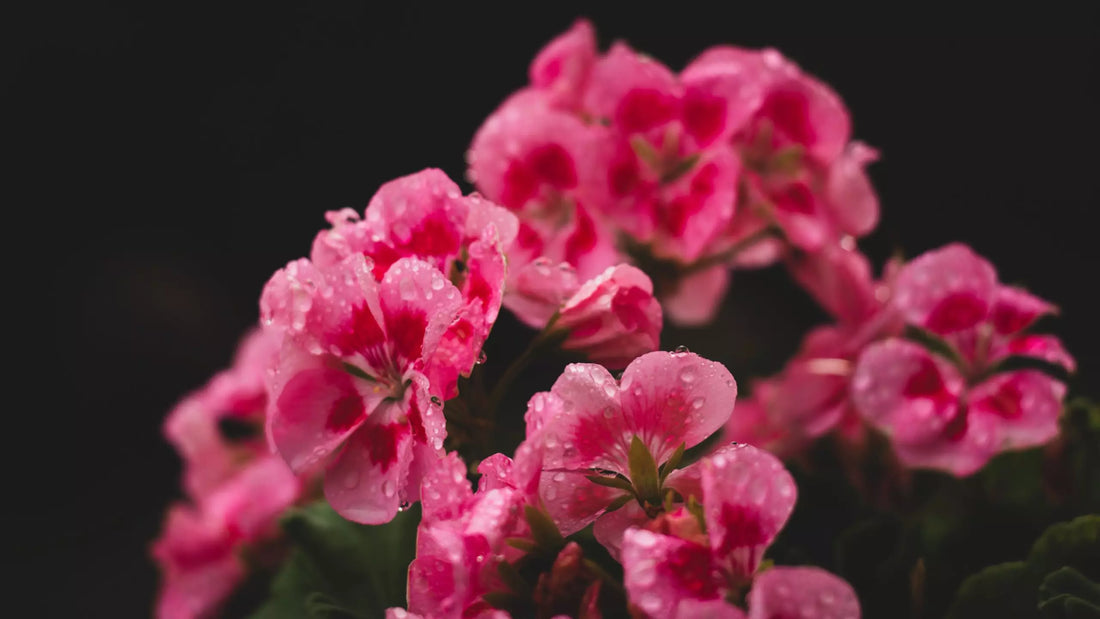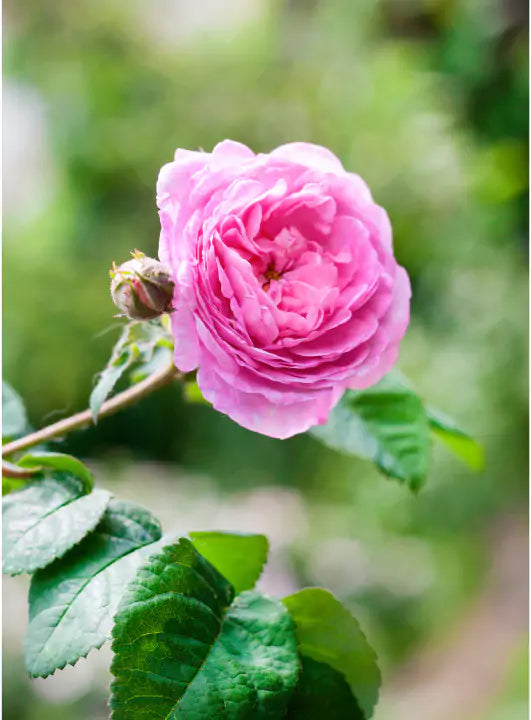
Rose Vs Geranium: Two Perfume Ingredients That Share Their Chemistry and Scent
Share
Explore two of the most iconic ingredients of perfumery – rose and geranium. Their scent is very close to one another... and this is due to their shared chemistry.
Rose, The Queen Of Flowers
From latin Rosa
Perhaps one of the most well known flowers of them all, also known as “The Queen of Flowers”. Rose is an incredible ingredients that is often misunderstood. For centuries the terms ‘feminine’ ‘floral’ and ‘powdery’ have been strong associations, and whilst these are all true, certain species of rose also carry a ‘fresh’ hint of ‘citrus’ as well as ‘clean’ ‘masculine’ ‘woody’ and even ‘fruity’ notes!
Rose in Perfumery
An impactful floral note, rose is prevalent all across the world in all shapes and sizes– not to mention the variety of smells and colours. However, the excessive cross breeding of roses to create a rainbow of colours, has unfortunately led to hybrid roses losing their scent. Rose extracts used in perfumery mainly come from two species: Damascena and Centifolia. Roses comes in two types of extracts in perfumery: as an essential oil or absolute (deeper and sweeter than its oil counterpart). Rose has stood the test of time thanks to it’s ability to blend perfectly with other floral, wood and citrus notes.
Rose extracts contains hundreds of molecules, which explains why its scent is so rich and multi-faceted. Rose perfumery extracts have citrusy (lemongrass) notes, green, fruity (peach, plum, wine), spicy (clove), amber and sweet facets all in one single scent!
Rose Essential Oil and Absolute
Hand picked early in the mornings when the scent is strongest, the essential oil from roses (mostly Rosa centifolia aka may rose and Rosa damascena aka damask rose) are extracted the same day using steam. The leftover rose water from the steaming process is commonly used in desserts but can also be found in some perfumes, to give a lighter fragrance.
Turkey, Bulgaria, France and Morocco are perhaps the most well known for their production of rose, but it isn’t cheap! The pure oil of rose is the most expensive of the rose oils used in perfumery. The amount of rain and sunshine a rose receives can affect it’s scent, so it’s important to not blend the same type of oil from different geographical locations or you could end up something rather interesting…!
Rose absolute will give you the most full bodied rose profile of all the varieties as it is rose in purest form.
The Chemistry Of Rose
Every flower species is made up from different molecules, some of which are responsible for giving it it’s scent. In roses these molecules include linalool, adlehydes, geraniol and citronellol (we won’t go on to list all 300). Rose oxide is a natural molecule found within rose with a metallic scent. Beware of the natural indole component (present in most flowers) that can make a rose oil smell slightly rotten…!
These molecules bring such excitement to the world of perfumery! Not only can you re-create the scent of rose (at a more affordable price) but you can recreate the same rose again and again, without having to worry about where it has come from or it’s harvest! Not only this, but it means you can create an endless variety of rose scents not found in the flowers themselves! Experimentation in it’s truest form.

Geranium, A Masculine Rose
From the Latin Pelargonium graveolens meaning strong-smelling. And it most certainly is!
When you think of geranium you’ll probably conjure up images of flower boxes on window sills, with beautiful pink and red flowers sitting elegantly, their scent filling your nose as you walk by. It’s not the flowers that carry its scent, but the leaves! If you crush a geranium leaf between your fingers, you’ll smell citrus and fruity accents with a hint of spice and a rose smell of course!
Generally, for its scent, geranium is often mistaken for ‘the other’ rose but with a less powdery and more lemony herbaceous aroma, with a soft but potent warm green scent.
Geranium in Perfumery
It is commonly used in many soaps and lotions, giving it a believed ‘soapy’ scent– which is also then why roses get a similar association– but is also often used in masculine fragrances.
Geranium is a great floral note to bring your top and base notes together, giving a boost to any other rose ingredients in a composition.
Geranium Essential Oil
Similar to rose, geranium oil is obtained by the distillation of the leaves and stalks. The liquid gives off a sharp and herbaceous green scent and with a sweet minty-rose undertone. Unlike rose, it’s much cheaper to obtain!
However, where rose generally carries a sweeter smell, geranium has an aromatic quality (similar to lavender) making it smell more ‘masculine’ to some noses. The extract is therefore used in many masculine perfumes, as well as the traditionally masculine Fougere and Chypre accords, although we see everyone enjoying its scent.
You can find the noble geranium absolute, a richer deeper extract to its counterpart essential oil, also comes at a higher price-tag!
The Chemistry of Geranium
The well known molecules found within geranium oil are citronellol, nerol, geraniol and linalool – many molecules shared with rose and which explains why they carry a similar scent profile! Nerol is found in lemongrass, contributing to geraniums lemony scent and geraniol is one of the primary components in rose oil, contributing to geraniums rosy smell!


